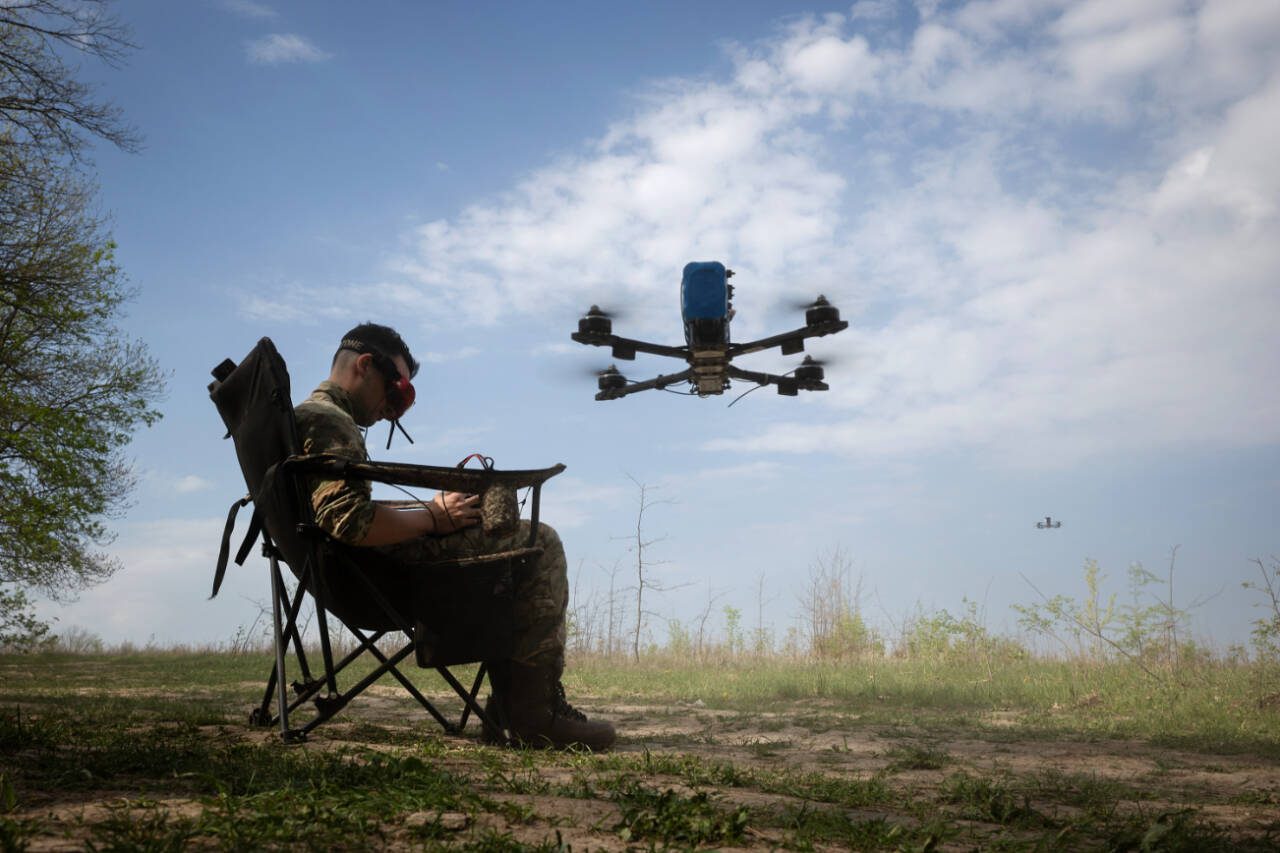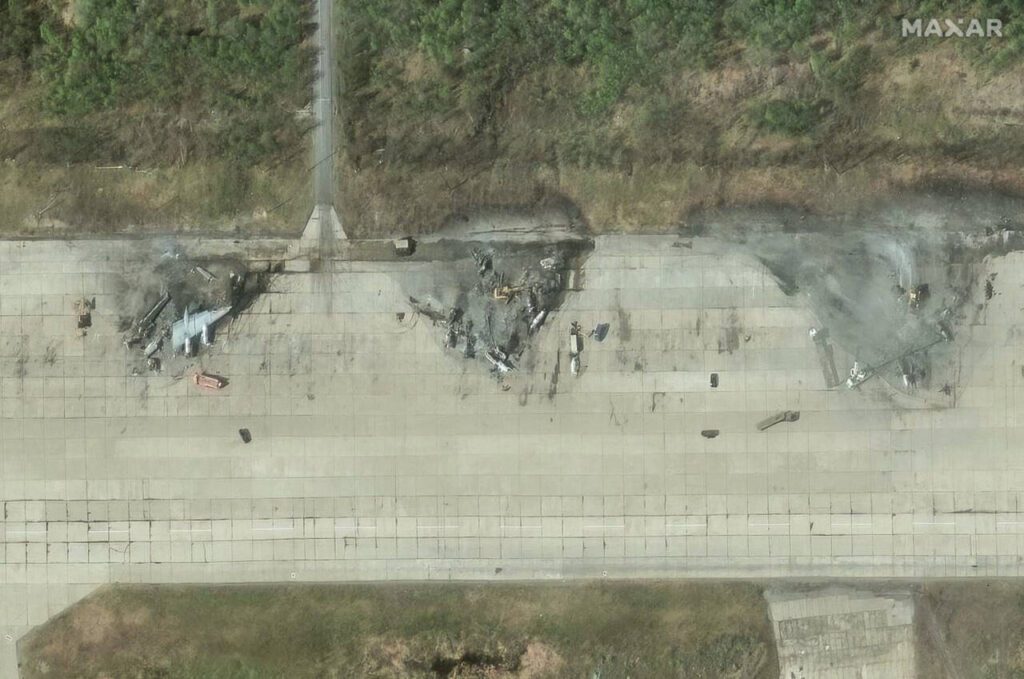By Benjamin Jensen / For The Conversation
A series of blasts at airbases deep inside Russia on June 1, came as a rude awakening to Moscow’s military strategists.
The Ukrainian strike at the heart Russia’s strategic bombing capability could also upend the traditional rules of war: It provides smaller military a blueprint for countering a larger nation’s ability to launch airstrikes from deep behind the front lines.
Ukraine’s Operation Spider Web involved 117 remote-controlled drones that were smuggled into Russia over an 18-month period and launched toward parked aircraft by operators miles away.
The raid destroyed or degraded more than 40 Tu-95, Tu-160 and Tu-22 M3 strategic bombers, as well as an A-50 airborne-early-warning jet, according to officials in Kyiv. That would represent roughly one-third of Russia’s long-range strike fleet and about $7 billion in hardware. Even if satellite imagery ultimately pares back those numbers, the scale of the damage is hard to miss.
The logic behind the strike is even harder to ignore.
Traditional modern military campaigns revolve around depth. Warring nations try to build combat power in relatively safe “rear areas”; logistics hubs that are often hundreds if not thousands of miles from the front line. These are the places where new military units form and long-range bombers, like those destroyed in Ukraine’s June 1 operation, reside.
Since the invasion of Ukraine in 2022, the Kremlin has leaned heavily on its deep-rear bomber bases; some more than 2,000 miles from the front in Ukraine. It has paired this tactic with launching waves of Iranian-designed Shahed attack drones to keep Ukrainian cities under nightly threat.
The Russian theory of victory is brutally simple: coercive airpower. If missiles and one-way drones fall on Kyiv often enough, civilian morale in Ukraine will crack, even as the advance of Russian ground forces get bogged down on the front line.
For Kyiv’s military planners, destroying launch platforms undercuts that theory far more cheaply than the only other alternative: intercepting every cruise missile in flight, which to date has achieved an 80 percent success rate but relies heavily on Western-donated equipment coming increasingly in short supply.
Airfield vulnerability: Airfields have always been critical targets in modern warfare, the logic being that grounded bombers and fighters are more vulnerable and easier to hit.
In the North African desert during World War II, the United Kingdom’s Special Air Service used jeep raids and delayed-action explosives to knock out an estimated 367 enemy aircraft spread across North Africa; firepower the Luftwaffe never regenerated. That same year, German paratroopers seized British-controlled airstrips on Crete, denying the Royal Air Force a forward base and tipping an entire island campaign.
A generation later in Vietnam, Viet Cong and North Vietnamese Army assault teams armed with satchel charges and mortars repeatedly penetrated U.S. perimeters at Phan Rang, Da Nang and Bien Hoa, burning fighters on the ramp and forcing the diversion of thousands of American soldiers to base security.
The underlying playbook of hitting aircraft on the ground remains effective because it imposes cascading costs. Every runway cratered and every bomber torched obliges the military hit to pour money into ways to frustrate such attacks, be it hardened shelters or the dispersal of squadrons across multiple bases. Such air attacks also divert fighters from the front lines to serve as guards.
A new age of drone warfare: In Operation Spider Web, Ukraine has sought to repeat that strategy while also leveraging surprise to achieve psychological shock and dislocation.
But the Ukraine operation taps into a uniquely 21st-century aspect of warfare.
The advent of unmanned drone warfare has increasingly seen military practitioners talk of “air littorals”; military speak for the slice of atmosphere that sits above ground forces yet below the altitude where high-performance fighters and bombers traditionally roam.
Drones thrive in this region, where they bypass most infantry weapons and fly too low for traditional radar-guided defenses to track reliably, despite being able to incapacitate targets like fuel trucks or strategic bombers.
By smuggling small launch teams of drones within a few miles of each runway, Kyiv created pop-up launchpads deep into Russia and were able to catch the enemy off guard and unprepared.
The economic benefits of Ukraine’s approach are stark. Whereas a drone, a lithium-battery and a warhead cost well under $3,000, a Russian Tu-160 bomber costs in the region of $250 million.
The impact on Russia: Ukraine’s Operation Spider Web will have immediate and costly consequences for Russia, even if the strikes end up being less destructive than Kyiv currently claims.
Surviving bombers will need to be relocated. Protecting bases from repeat attacks will mean erecting earthen revetments, installing radar-guided 30mm cannons and electronic-warfare jammers to cover possible attack vectors. This all costs money. Even more importantly, the operation will divert trained soldiers and technicians who might otherwise rotate to the front line in support of the coming summer offensive.
The raid also punches a hole in Russia’s nuclear weapons capabilities.
Losing as many as a dozen Tu-95 and Tu-160 aircraft, which double as nuclear-capable bombers, would be strategically embarrassing and may prod the Kremlin to rethink the frequency of long-range air patrols.
Beyond the physical and financial damage to Russia’s fleet, Ukraine’s operation also comes with a potent psychological effect. It signals that Ukraine, more than three years into a war aimed at grinding down morale, is able to launch sophisticated operations deep into Russian territory.
Ukraine’s security service operation unfolded in patient, granular steps: 18 months of smuggling disassembled drones and batteries across borders inside innocuous cargo, weeks of quietly reassembling kits, and meticulous scouting of camera angles to ensure that launch trucks would be indistinguishable from normal warehouse traffic on commercial satellite imagery.
Operators drove those trucks to presurveyed firing points and then deployed the drones at treetop height.
Because each of the drones was a one-way weapon, a dozen pilots could work in parallel either close to the launch site or remotely, steering live-video feeds toward parked bombers. Videos of the strike suggest multiple near-simultaneous impacts across wide swaths of runway; enough to swamp any ad hoc small-arms response from perimeter guards.
A new front line?: For Ukraine, the episode demonstrates a repeatable method for striking deep, well-defended assets. The same playbook can, in principle, be adapted to missile storage depots and, more importantly, factories across Russia mass-producing its Shahed attack drones.
Kyiv has needed to find a way to counter the waves of drones and ballistic missile strikes that in recent months have produced more damage than Russian cruise missiles. The Center for Strategic and International Studies’ Firepower Strike Tracker has shown that Shaheds are now the most frequent and most cost-effective air weapon in Russia’s campaign.
But the implications of Operation Spider Web go far beyond the Russia-Ukraine conflict by undermining the old idea that rear areas are safe. Comparatively inexpensive drones, launched from inside Russia’s own territory, wiped out aircraft that cost billions and underpin Moscow’s long-range strike and nuclear signaling. That’s a strategy than can be easily replicated by other attackers against other countries.
Anyone who can smuggle, hide and pilot small drones can sabotage an adversary’s ability to generate air attacks.
Air forces that rely on large, fixed bases must either harden, disperse or accept that their runway is a new front line.
Benjamin Jensen is a scholar in residence and professorial lecturer at the American University School of International Service, Washington, D.C. This article is republished from The Conversation under a Creative Commons license.
Talk to us
> Give us your news tips.
> Send us a letter to the editor.
> More Herald contact information.


























